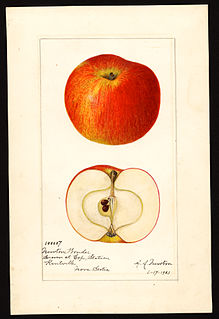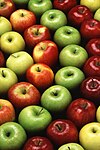
Salvia rosmarinus, commonly known as rosemary, is a shrub with fragrant, evergreen, needle-like leaves and white, pink, purple, or blue flowers, native to the Mediterranean region. Until 2017, it was known by the scientific name Rosmarinus officinalis, now a synonym.

'Golden Delicious' is a yellow apple, one of the 15 most popular cultivars in the United States. It is not closely related to 'Red Delicious'.

Malus is a genus of about 30–55 species of small deciduous trees or shrubs in the family Rosaceae, including the domesticated orchard apple – also known as the eating apple, cooking apple, or culinary apple. The other species are commonly known as crabapples, crab apples, crabtrees, wild apples, or rainberries.

Pelargonium is a genus of flowering plants which includes about 280 species of perennials, succulents, and shrubs, commonly known as geraniums, pelargoniums, or storksbills. Geranium is also the botanical name and common name of a separate genus of related plants, also known as cranesbills. Both genera belong to the family Geraniaceae. Carl Linnaeus originally included all the species in one genus, Geranium, and they were later separated into two genera by Charles Louis L'Héritier de Brutelle in 1789.

Malus domestica is a cultivar of apple that is usually eaten cooked due to its sourness. The variety comes from a pip planted by Mary Ann Brailsford. The Concise Household Encyclopedia states, "Some people eat this apple raw in order to cleanse the palate, but Bramley's seedling is essentially the fruit for tart, pie, or dumpling." Once cooked, however, it has a lighter flavour. A peculiarity of the variety is that when cooked it becomes golden and fluffy. Vitamin C 15mg/100g.

The Haralson is a cultivar of apple that is medium-sized and has a round-conic shape.

An apple is an edible fruit produced by an apple tree. Apple trees are cultivated worldwide and are the most widely grown species in the genus Malus. The tree originated in Central Asia, where its wild ancestor, Malus sieversii, is still found today. Apples have been grown for thousands of years in Asia and Europe and were brought to North America by European colonists. Apples have religious and mythological significance in many cultures, including Norse, Greek, and European Christian tradition.
The 'Summerfree' is an apple cultivar first developed in Italy in the 1990s by crossing 'PRI 1956-6' and 'Ed Gould Golden' apples. Resistant to apple scab, it has a spreading habit with moderate vigor, the fruit are large with an average weight of 175 g, the skin is smooth, it ripens one to two months before 'Gala', and it has good storage ability.

The 'Laxton's Superb' is an apple cultivar that was developed in England in 1897. It is a cross breed between Cellini and 'Cox's Orange Pippin' and is not a cross between Wyken Pippin and Cox Orange Pippin. It is a British apple with a green color and a dull red flush. It is a firm-textured dessert apple. The fruit is well known for its sweet and aromatic taste which is likened to the parent species it is derived from, the 'Cox's Orange Pippin'. Density 0,82 g/cc, sugar 14,0%, acid 7,4 g/litre. Vitamin C 9mg/100g.

Malus domestica Newton Wonder is a cultivar of apple which is usually eaten cooked due to its sourness. The variety has a similar but slightly sweeter taste than the Bramley apple and is usually used in pies or as a preserve.

Lord Lambourne is an apple cultivar with a sweet sharp flavor. It was raised by Laxtons Brothers Ltd in 1907 in Bedford, England. It is a holder of the Royal Horticultural Society Award of Garden Merit

'Worcester Pearmain' is an early season English cultivar of domesticated apple, that was developed in Worcester, England, by a Mr. Hale of Swanpool in 1874. It was once the most popular cultivar in England for early autumn harvest and is still popular to keep in the garden. It has been extensively used in apple breeding.

King of the Pippins or Reine des Reinettes (French) is an old cultivar of domesticated apple originating from France, and is still used in its original form as well as in many derivative cultivars that have been bred from it. It was also formerly known as Golden Winter Pearmain, because of its ripening period at late fall.

Ellison's Orange is an English cultivar of domesticated apple, it is a cross between the famous Cox's Orange Pippin and Cellini, which it resembles at most in looks and taste, but can develop a distinct aniseed flavor in storage. The variety is much more disease resistant than Cox's and therefore easier to cultivate.

Winston is an English cultivar of domesticated apple which was first named Winter King because of its availability in the winter, but was renamed as Winston in 1944 or in 1945, after Winston Churchill.

Suntan is an English cultivar of domesticated apple that have earned the Award of Garden Merit by the Royal Horticultural Society in 1999.

Grenadier is an English cultivar of domesticated apple mainly used for cooking. It originated in the mid-19th century in Buckinghamshire. It was first recorded in 1862 in Maidstone, Kent, exhibited by Charles Turner of Slough, Berkshire, and then commercially introduced by Bunyard Nursery.

The Field Elm cultivar Ulmus minor 'Dicksonii', commonly known as Dickson's Golden Elm, is a yellow-leaved tree raised in Chester in 1900 by Dickson's Nursery, which distributed it from the autumn of 1907 as 'Golden Cornish Elm'. 'Cornish Elm' was the name often given in error to Guernsey or Wheatley Elm by the local authorities who planted the latter extensively, an error which may have influenced the choice of name by Dickson's nursery. 'Dicksonii' is usually listed as a variety of Guernsey Elm rather than Cornish Elm, Bean giving 'Wheatleyi Aurea' as a synonym, and Hillier 'Sarniensis Aurea' and later U. × sarniensis 'Dicksonii'. Clibrans' nursery of Altrincham, however, described it (1922) as otherwise identical "in habit and constitution" to 'type' Cornish Elm. The Späth nursery of Berlin distributed it from c.1913 as U. campestris cornubiensis Dicksonii. The nursery Messieurs Otin père et fils of Saint-Étienne sold an Ulmus Wheatleyi aurea pyramidalis, with leaves marbled yellow, in 1882, earlier than Dickson's introduction.

Autumn Glory is an apple cultivar developed by Domex Superfresh Growers, which is based in Washington (state). The fruit is marketed as Autumn Glory. The fruit, which has cinnamon tasting notes, is grown by Domex Superfresh Growers with a production of about 56,000 trees as of November 2014. Autumn Glory apples have a very sweet, firm flesh with hints of cinnamon and subtle notes of caramel. After being in development for a decade, the apple was released in the 2011 season. The Autumn Glory variety is a hybrid of the Fuji (apple) and Golden Delicious apple with a red coloring on a yellow background. The original pollination cross breed was made by Dr. Yu Lin Wang in 1976. It is picked in mid- to late-October of each year.




















